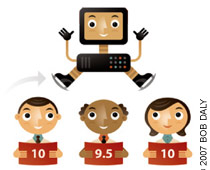
If you already use an electronic health record system, here's your chance to help your colleagues who haven't yet made the leap.
Fam Pract Manag. 2007;14(4):27-30
Dr. Adler is a family physician in full-time clinical practice in Tucson, Ariz. He has a Master of Medical Management degree from Tulane University and a Certificate in Healthcare Information Technology from the University of Connecticut. Robert Edsall is editor-in-chief of Family Practice Management. Author disclosure: nothing to disclose.

In this issue, FPM is publishing its second electronic health records (EHR) user survey – not the results yet, but the survey form itself, as a means of data collection. The survey instrument was developed in cooperation between the editors of FPM and Kenneth G. Adler, MD, MMM. The survey is modified and expanded from an EHR demonstration rating form we published two years ago.1 The first EHR user survey elicited input from more than 400 family physicians, whose responses provided helpful advice for those still facing the decision to go electronic and wondering which system to choose.2,3 This year's survey follows the same model but is shorter and easier to complete than the original survey.
The intent of this survey is not to arrive at a picture of the current state of EHR use among family physicians. We simply want to collect satisfaction data from as many family physician users of as many different EHR systems as possible. By publishing product-specific results in an upcoming issue of FPM, we aim to help future purchasers of EHR systems make sound choices for their practices.
Your colleagues need you
If you use an EHR, please complete the survey. Even if you responded to the 2005 survey, we need your input on this one. Your system and your opinion have likely changed in the intervening time. And if you benefitted from the information in the 2005 report, pay the benefit forward by completing the survey yourself this time. The survey project will succeed in direct proportion to the number of family physicians who respond. You can be sure that, where six family physicians use the same EHR, all six are likely to have different opinions of the system. Prospective users could benefit from all six views. The ideal is to obtain a response from every family physician who uses a commercially available EHR system. Still, the broadcast nature of this survey requires some validation of responses to guarantee that respondents are indeed family physicians, that no one is submitting multiple responses to the survey, etc. The most practical means of validation available is, as it was in 2005, verification of AAFP membership. Consequently, the survey asks for your membership number. Only responses from AAFP members will be tabulated.
Completing the survey
We realize that this survey will take time out of your already busy day. With that in mind, we have shortened it considerably from the first version. We want to thank you in advance for responding. By doing so, you will help many of your fellow family physicians and provide feedback to vendors that spurs improvements in EHR technology.
To maximize the number of valid responses and to make responding as convenient as possible, we are publishing the survey instrument both in this issue of FPM and online through the FPM Web site. The easiest way to submit a survey is to go online to https://www.aafp.org/fpm/ehrsurvey. By providing your responses electronically, you will facilitate the analysis process. Alternatively, you can download and print a PDF version by clicking below, complete it by hand, and return the results either by fax to 913-906-6010 or by mail to Family Practice Management, 11400 Tomahawk Creek Pkwy, Leawood, KS 66211. Be sure to respond by July 31, 2007. Hundreds of your colleagues will thank you.